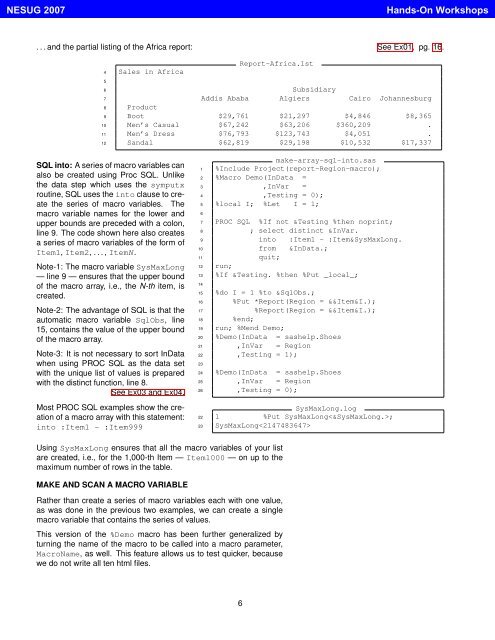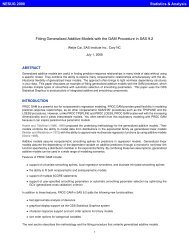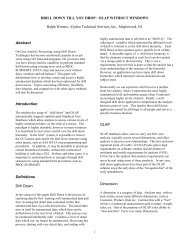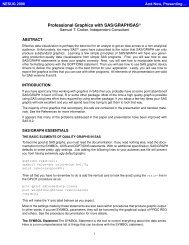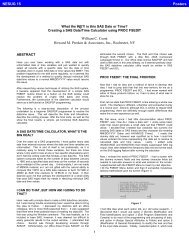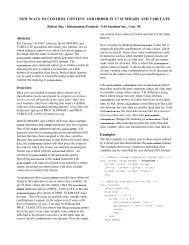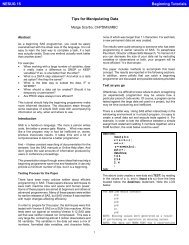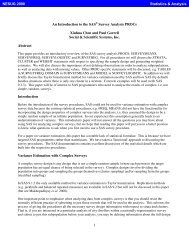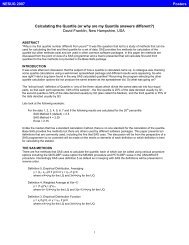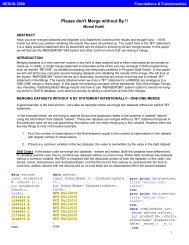List Processing Basics: Creating and Using Lists of Macro ... - NESUG
List Processing Basics: Creating and Using Lists of Macro ... - NESUG
List Processing Basics: Creating and Using Lists of Macro ... - NESUG
Create successful ePaper yourself
Turn your PDF publications into a flip-book with our unique Google optimized e-Paper software.
<strong>NESUG</strong> 2007H<strong>and</strong>s-On Workshops. . . <strong>and</strong> the partial listing <strong>of</strong> the Africa report: See Ex01, pg. 16.4 Sales in Africa5Report-Africa.lst6 Subsidiary7 Addis Ababa Algiers Cairo Johannesburg8 Product9 Boot $29,761 $21,297 $4,846 $8,36510 Men’s Casual $67,242 $63,206 $360,209 .11 Men’s Dress $76,793 $123,743 $4,051 .12 S<strong>and</strong>al $62,819 $29,198 $10,532 $17,337SQL into: A series <strong>of</strong> macro variables canalso be created using Proc SQL. Unlikethe data step which uses the symputxroutine, SQL uses the into clause to createthe series <strong>of</strong> macro variables. Themacro variable names for the lower <strong>and</strong>upper bounds are preceded with a colon,line 9. The code shown here also createsa series <strong>of</strong> macro variables <strong>of</strong> the form <strong>of</strong>Item1, Item2, . . . , ItemN.Note-1: The macro variable SysMaxLong— line 9 — ensures that the upper bound<strong>of</strong> the macro array, i.e., the N-th item, iscreated.Note-2: The advantage <strong>of</strong> SQL is that theautomatic macro variable SqlObs, line15, contains the value <strong>of</strong> the upper bound<strong>of</strong> the macro array.Note-3: It is not necessary to sort InDatawhen using PROC SQL as the data setwith the unique list <strong>of</strong> values is preparedwith the distinct function, line 8.See Ex03 <strong>and</strong> Ex04.Most PROC SQL examples show the creation<strong>of</strong> a macro array with this statement:into :Item1 - :Item999make-array-sql-into.sas1 %Include Project(report-Region-macro);2 %<strong>Macro</strong> Demo(InData =3 ,InVar =4 ,Testing = 0);5 %local I; %Let I = 1;67 PROC SQL %If not &Testing %then noprint;8 ; select distinct &InVar.9 into :Item1 - :Item&SysMaxLong.10 from &InData.;11 quit;12 run;13 %If &Testing. %then %Put _local_;1415 %do I = 1 %to &SqlObs.;16 %Put *Report(Region = &&Item&I.);17 %Report(Region = &&Item&I.);18 %end;19 run; %Mend Demo;20 %Demo(InData = sashelp.Shoes21 ,InVar = Region22 ,Testing = 1);2324 %Demo(InData = sashelp.Shoes25 ,InVar = Region26 ,Testing = 0);SysMaxLong.log22 1 %Put SysMaxLong;23 SysMaxLong<strong>Using</strong> SysMaxLong ensures that all the macro variables <strong>of</strong> your listare created, i.e., for the 1,000-th Item — Item1000 — on up to themaximum number <strong>of</strong> rows in the table.MAKE AND SCAN A MACRO VARIABLERather than create a series <strong>of</strong> macro variables each with one value,as was done in the previous two examples, we can create a singlemacro variable that contains the series <strong>of</strong> values.This version <strong>of</strong> the %Demo macro has been further generalized byturning the name <strong>of</strong> the macro to be called into a macro parameter,<strong>Macro</strong>Name, as well. This feature allows us to test quicker, becausewe do not write all ten html files.6


